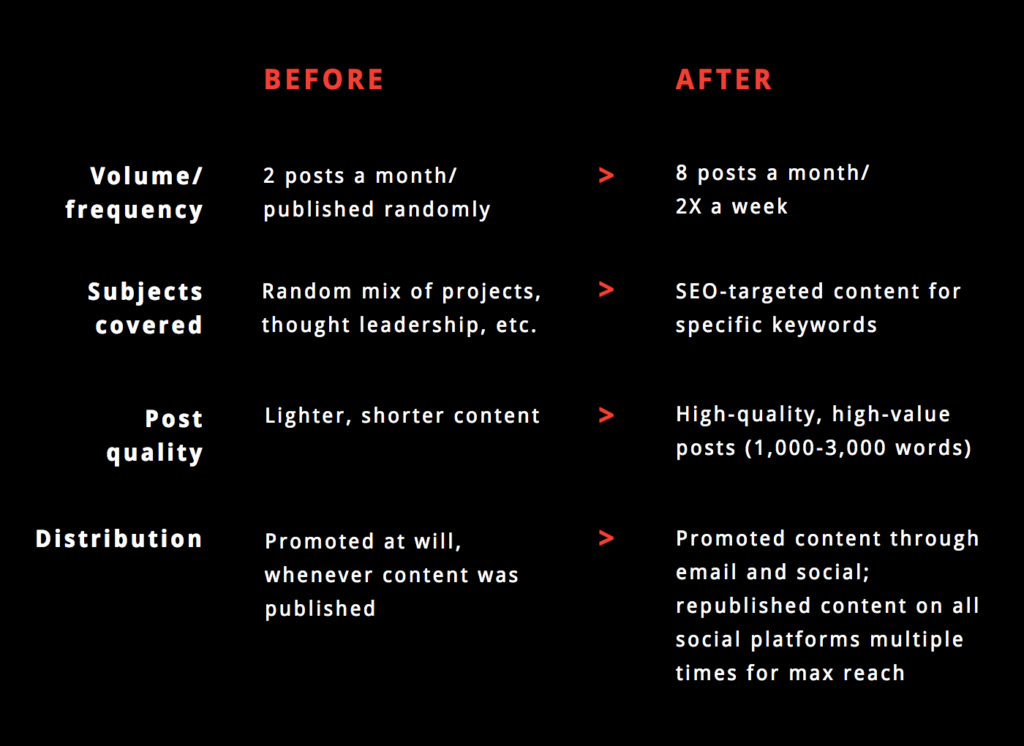We’re all about content marketing. Marketing strategy, writing, designing—we have our clients covered. But sometimes we feel like a chef in a 5-star restaurant who’s tempted to reach for a Big Mac after a long shift. After putting all our heart into the work we do for others, the last thing we want to do is go home and cook up our own content, so to speak. But we know that’s not how you make shit happen in marketing.
That’s why we made a change last year. We decided to upgrade our marketing. We revamped our entire content operation, including a new strategy, new team, and new ideas. We brought in people from every department, and we got some outside perspective from niche experts when we felt like we could use the extra help. It was a lot of work, but it has paid off so far.
In only 6 months, we saw some pretty sweet results, which we’re still savoring. And since we like to help everyone get better results from their marketing efforts, we’re sharing the story—and success—of how we did it in hopes that you find something useful to apply to your own organization.
How We Gave Our Marketing Strategy a Makeover
Prior to last year, we hadn’t totally neglected our own marketing, but we hadn’t always made it a priority, either. Sure, we’d kick out a newsletter when we had a big announcement. We’d post a project or article on our blog here and there. We’d run a paid campaign when we came out with an e-book. These actions brought decent results, but our marketing sprints were inconsistent and scattered. It also felt like pulling teeth to get anything created for ourselves. But worst of all, there was a lingering feeling that this wasn’t sustainable.
For a long time, it wasn’t much of an issue. We’ve been lucky to have wonderful partners and great word of mouth over the last 8 years. But our organization has also grown and our business strategy has shifted over that same time period. To achieve our goals, we realized we needed to build up our marketing operation to create a cohesive buyer’s journey that included both marketing and sales. So, we got to work.
Step 1: The Team
To start, we assembled a lean marketing team. We believe in building marketing teams based on flexible roles vs. specific positions. (Read more about that here.) This philosophy helped us do a lot with our small outfit, which included:
- Marketing Manager: Brian Wolford
- Managing Editor: Katy French
- Cofounder/CEO/Marketing Director/Janitor: Josh Ritchie
Plus supporting members:
- Creative Director: Nate Butler
- Strategic Partnerships Manager: Sara Bacon
Step 2: The Audit
Because our organization and competitive landscape had changed so much in recent years, we were prepared to rebuild our strategy from scratch. So, we went back to square one.
To get a sense of our current situation, we first debriefed to discuss our current and past efforts, as well as what did and didn’t work. We also brought our sales team into the conversation. Since we were focused on creating a cohesive buyer’s journey, the sales crew helped us determine what part of the journey marketing could and should facilitate.
This exercise gave us a much better understanding of how our teams would complement each other, as well as how our efforts would support Column Five’s short- and long-term goals. (This is especially important, as we see a lot of marketers go full-steam ahead with a strategy, without understanding the context of their work in terms of the bigger picture.)
Step 3: The Plan
Based on our audit conversations, we were able to craft a cohesive plan—outlining our goal, objectives, strategies, and tactics, as well as the KPIs we’d use to track our progress.
Throughout the planning process, we prioritized actions using our existing resources that would make the biggest impact. We also focused on what we could do now vs. what we wanted to do someday. (When you’re thinking big picture, it’s easy to get caught up in “what ifs” and leave with a grand, vague, and therefore weak plan.)
As each level of planning builds on the other, we wanted to make sure that everything we did supported a single, focused goal. Inspired by our company’s vision (to help build a world where everyone can live healthy and fulfilled lives), our goal was to attract more of the work we crave.

Of course, a goal is nice, but we needed a measurable objective to support the goal.

There are many ways to attract leads, but we focused on the strategies we determined would best attract those leads—specifically content marketers. For this, we honed in on 3 main strategies.
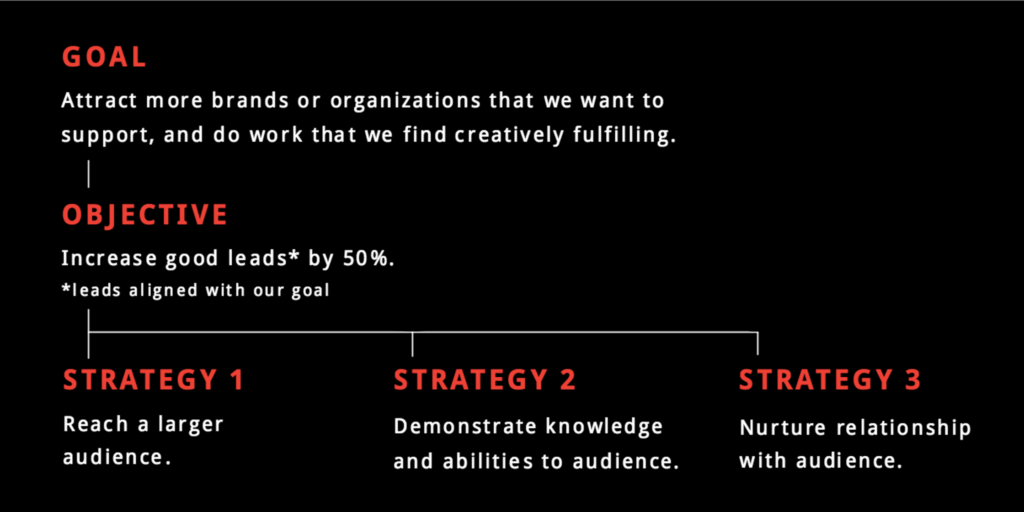
Then we got into the nitty-gritty. Again, we were focused on making the most impact with our at-hand resources, so we identified the tactics we could each tackle. Some of these were low-hanging fruit; others were a little more involved. We also determined the most useful KPIs.
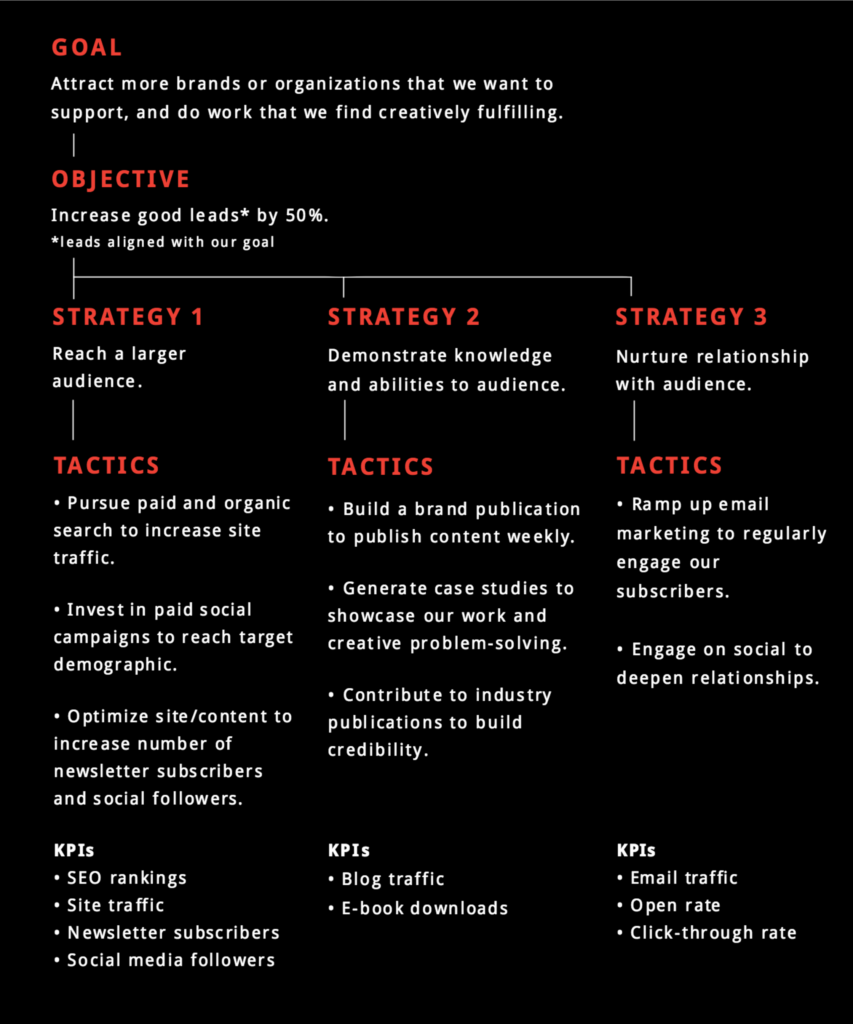
With our comprehensive plan in place, we were ready to get cracking.
Step 4: The Execution
There was plenty of work to be done.
Strategy 1: Reach a larger audience
Tactics
- Pursue paid and organic SEO to increase site traffic.
- Invest in paid social campaigns to reach target demographic.
- Optimize site and content to increase number of newsletter subscribers and social followers.
Paid and Organic Search
We needed more visibility in general and specifically for our core services. There are a million things you can do to improve your SEO (our heads were swimming at times), but we determined the best strategy for our particular goals and tackled the most pertinent to-dos in each area.
Paid: We had previously run paid campaigns, but this time around we directed our spending on search, display, and retargeting for keywords and phrases related to all of our services. We wanted as many as possible to have high search volume with low CPC (cost-per-click).
Organic: We had a decent amount of content on our site, but most of our pieces were several years old. To garner more traffic, we focused on:
- Keyword-specific content: We created high-value content around targeted keywords, providing an array of content for particular subjects.
- Link-building: To boost our rankings, we pursued links from pages that already ranked for our keywords and phrases. For example, we started to reach out to “best [keyword] agencies” and “top 50 [keyword] agencies” sites to confirm we were included, along with a link back to our site.
Paid Social Campaigns
We ran more targeted ads on Facebook, Twitter, and LinkedIn. In addition to boosting our content on Facebook and Instagram, we also implemented video campaigns with retargeting ads on Facebook.
Site optimization
As visual communicators, design is incredibly important to us. Unfortunately, search engines don’t care about a beautiful portfolio. So, we met in the middle and tweaked our site for both search engines and user experience. This included:
- Updated messaging
- Streamlined design
- More visible CTAs and contact forms
- More content on work services landing pages
- A social plugin to make our content easier to share
- A newsletter exit popup with e-book download (only added to blog and high-traffic portfolio pages)
The results
We started our new marketing strategy halfway through the year, in June 2016. And we immediately saw results.
SEO rankings for all of our keywords improved significantly: 10 of our service keywords now rank on page 1 of Google results.

See all the content we created for annual reports here.
In the second half of the year, traffic also jumped—79% June through December, compared to Jan through May.
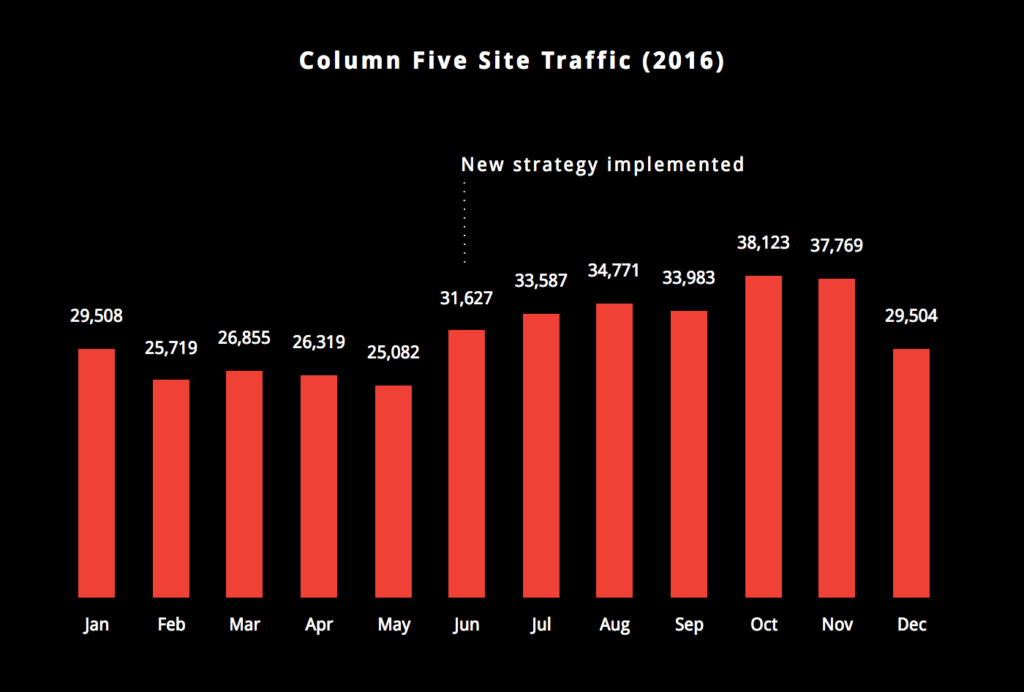
And traffic from all channels increased.
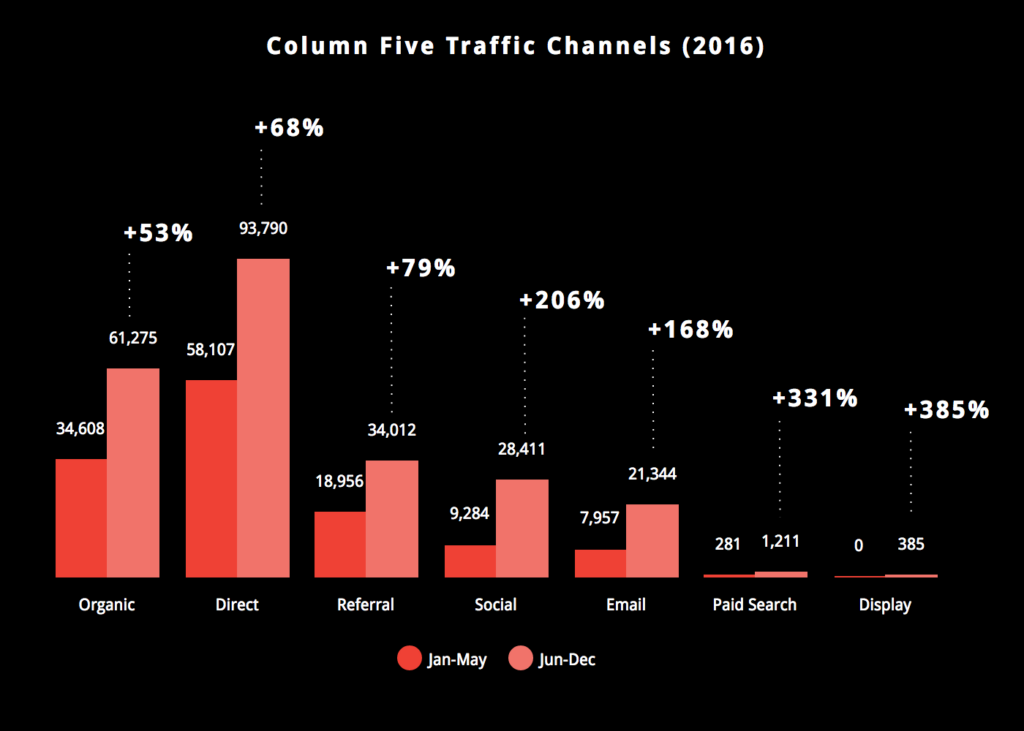
Our link-building efforts, as well as paid search and social campaigns, also paid off. While still a small percentage of total traffic, traffic from these channels jumped significantly.
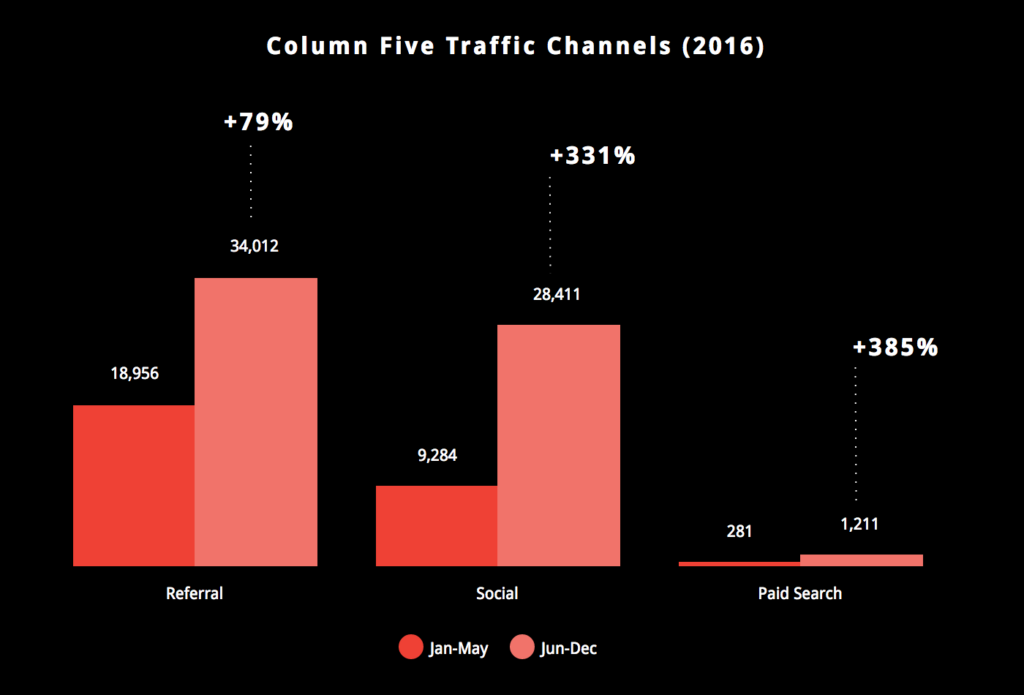
And our site optimization efforts worked. Contact form completion increased 35% thanks to our redesign. Thanks to the exit popup, newsletter signups also increased—344% in the second half of the year.
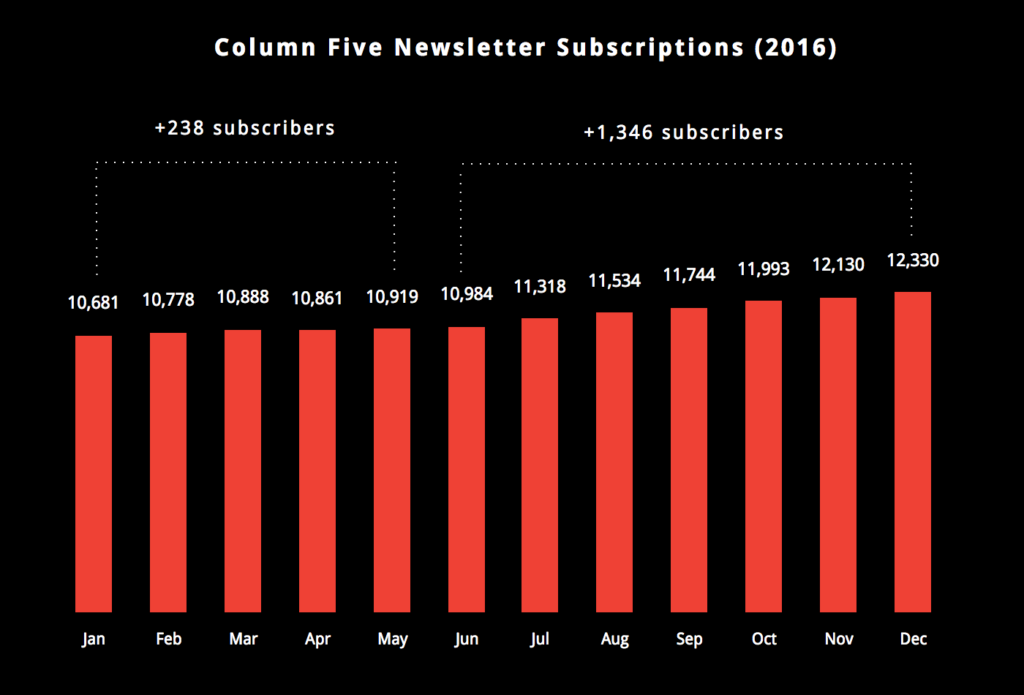
Social followers also increased 21%.
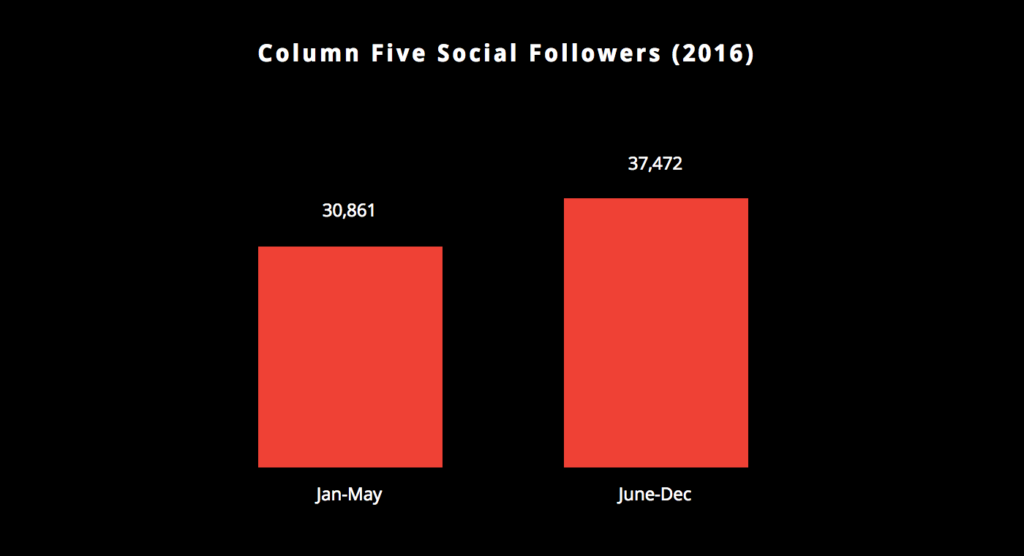
Strategy 2: Demonstrate our knowledge and abilities
Tactics
- Build a brand publication to publish content weekly.
- Generate case studies to showcase our work and creative problem-solving.
- Contribute to industry publications to build credibility.
Brand Publication
We had always had a blog, but it often took a backseat. To really operate as a brand publisher, we revamped our editorial strategy to focus on producing valuable content for our audience—consistently. We defined valuable as:
- Useful: It would educate our audience or provide the tips, resources, and tools to do better content marketing.
- Relevant: It would address our audience’s concerns and speak to them at their level.
- Comprehensive: It would be worth their time to read.
Many brands, including us, have made the mistake of leading with brand-centric content, focusing on what you want to say and do. But the most effective content is created from an empathetic approach: focusing on what your audience needs and how you can help them. To create this content, we tweaked our editorial process.
- We created marketing personas to identify segments of our audience. (Find out how to create your own here.) Whenever we had an idea for an article, we vetted it through our personas so that we knew who each article was for and what pain point it was addressing.
- We identified our target keywords and ideated content to help us gain more SEO visibility. We also analyzed content gaps in our own archive and created additional posts to make sure we were covering our subjects from every angle.
- We stuck to a consistent publishing schedule.
- We created a distribution strategy to maximize reach, including earned and owned channels. Using CoSchedule (a super convenient editorial calendar/social-sharing tool), we set up a specific publishing schedule for every article, ensuring it would go out multiple times throughout the month on every social platform (and with different messaging).
Contributorships
In addition to focusing on our own publishing efforts, we looked for opportunities to share our hard-earned knowledge with larger audiences. We began partnerships with major industry publications, contributing posts to HubSpot, Newscred, LinkedIn Marketing Solutions, and Forbes. We also published interviews with many movers and shakers at these publications (and other companies) to help our audience learn from their knowledge.
Case studies
We created fresh case studies and made them more visible on our site. To demonstrate our knowledge and project success, we crafted case studies as stories that centered on ROI and experimentation, including client testimonies, etc.
The Results
Our efforts paid off tremendously. From June-December, blog traffic increased 190% and accounted for 46% of site traffic (up from 28% the previous period). Our contributorships also added to the 79% jump in referral traffic site-wide.

More traffic, along with the exit popup, increased e-book downloads 80%.
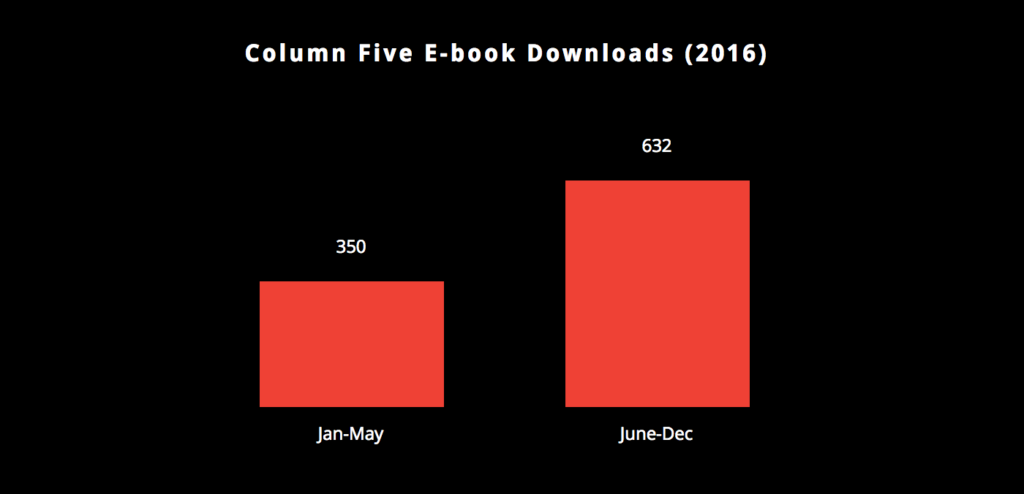
Strategy 3: Nurture relationships
Tactics
- Ramp up email marketing to regularly engage our subscribers.
- Engage on social to deepen relationships.
Email marketing
We had a decent email list, but we certainly weren’t making the most of it. (Again, we’d occasionally kick out piecemeal stuff.) Luckily, our list began to grow when we added the exit popup. In an effort to promote our content, engage that audience, and provide useful information, we increased our outreach.
We sent out a newsletter for everything we posted on the blog and tweaked how we worded those emails. Back in the day, we’d send out a long recap and link. In the interest of serving our audience, we made emails short, sweet, and to the point.
We also created drip campaigns for targeted segments and A/B tested like crazy. These campaigns first highlighted pieces of work that the target audience would be interested in, then followed up with other offers and attempts to start conversations about doing similar work together.
Social Engagement
As a visual agency, our Instagram has always been popping, but we rarely found time to devote to our other channels: Twitter, LinkedIn, Facebook, etc. As part of our revamped social strategy, which included heavier social spending, we pushed more content out through social to maintain a steady stream and engage followers on each platform.
The Results
Our increased email marketing contributed to the 168% increase in email traffic. We didn’t hit our open rate goal of 30%, but our 22% number is on par with the creative services/agencies industry benchmark. Even better, our click-through rate averaged 14%, well above the 2.6% industry benchmark.
So, how’d we do on our goal?
Pretty freaking awesome. From the first half of the year to the last, we saw leads increase 78%. Compared to 2015, leads were up 51%.

What we learned
It is so encouraging to see our hard work pay off—but we’ve definitely stumbled along the way and learned a hell of a lot. It taught us a lot about trying new things (and really living our core value to Experiment Often). Our biggest takeaways:
Testing changes lives: It may seem inconvenient or scary to try something different, but it will always help you learn. For example, as we experimented with email subject lines, we learned that any “How to…” or any number-based “X ways/tips/reasons…” always out-performed other variations. Additionally, we also found that we got more click-throughs by hyperlinking phrases related to the blog post instead of “click here.”
Tracking is everything: We were able to see such great results, test, and change course because we greatly improved our lead tracking (specifically by cleaning up how we labeled sources).
Refine, refine, refine: When you try something new, the fact that you’re doing it at all can feel like an accomplishment. But if it isn’t working efficiently, it’s time to experiment with your experiments. For example, we were so enthusiastic about creating keyword-targeted content that we tried to do too many posts on too many things. We soon realized it was more efficient to choose a small family of keywords and knock that content out of the park.
Your instincts can be wrong: Data is a friend for a reason. If the data is disproving your “theories,” listen to the data. For example, we were sure Twitter would be a larger source of leads, but we found our efforts there generated next to nothing. Similarly, we started out with an ambitious publishing schedule of 3 posts a week before realizing doing so actually brought our views per post down. We found 2 to be the sweet spot—and saved ourselves energy and time to focus on other important content, such as e-books.
Smaller can actually be better: Because we had a lean team, everyone took ownership of their responsibilities to make sure things got done. Larger teams can quickly stagnate in endless levels of approval or discussions over strategy.
Despite our wins, we know it’s a long road ahead. Our 2017 company mantra is to “fail better.” It’s an intimidating philosophy, but we plan to put it to the test.
We hope this post was helpful—and we hope you’ll share your own experiments in marketing, as well. For more tips on great marketing, find out how to build an agile visual content strategy, the 7 traits that will make you a better marketer, and how to create content that provides true value to your audience. And of course, if you need help with your own strategy, we’d love to chat.


